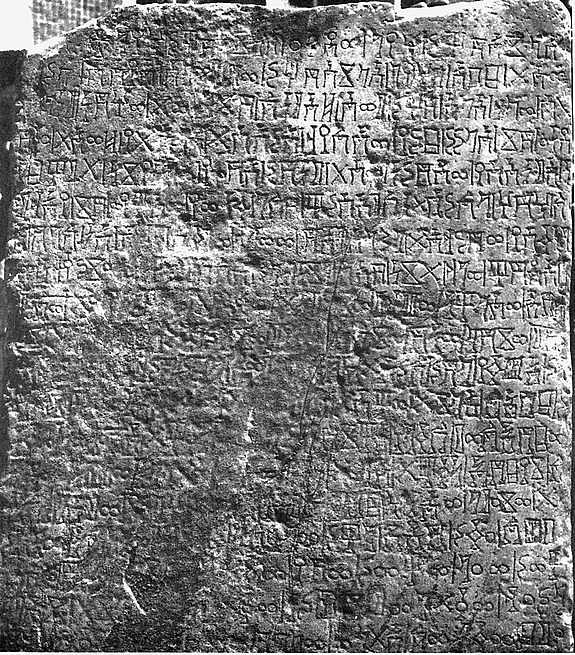The Rise and Fall of a Jewish Kingdom in Arabia

In these turbulent times in the Middle East, I have found myself working on the rise and fall of a late antique Jewish kingdom along the Red Sea in the Arabian peninsula. Friends and colleagues alike have reacted with amazement and disbelief when I have told them about the history I have been looking at. In the southwestern part of Arabia, known in antiquity as Himyar and corresponding today approximately with Yemen, the local population converted to Judaism at some point in the late fourth century, and by about 425 a Jewish kingdom had already taken shape. For just over a century after that, its kings ruled, with one brief interruption, over a religious state that was explicitly dedicated to the observance of Judaism and the persecution of its Christian population. The record survived over many centuries in Arabic historical writings, as well as in Greek and Syriac accounts of martyred Christians, but incredulous scholars had long been inclined to see little more than a local monotheism overlaid with language and features borrowed from Jews who had settled in the area. It is only within recent decades that enough inscribed stones have turned up to prove definitively the veracity of these surprising accounts. We can now say that an entire nation of ethnic Arabs in southwestern Arabia had converted to Judaism and imposed it as the state religion.
This bizarre but militant kingdom in Himyar was eventually overthrown by an invasion of forces from Christian Ethiopia, across the Red Sea. They set sail from East Africa, where they were joined by reinforcements from the Christian emperor in Constantinople. In the territory of Himyar, they engaged and destroyed the armies of the Jewish king and finally brought an end to what was arguably the most improbable, yet portentous, upheaval in the history of pre-Islamic Arabia. Few scholars, apart from specialists in ancient South Arabia or early Christian Ethiopia, have been aware of these events. A vigorous team led by Christian Julien Robin in Paris has pioneered research on the Jewish kingdom in Himyar, and one of the Institute’s former Members, Andrei Korotayev, a Russian scholar who has worked in Yemen and was at the Institute in 2003–04, has also contributed to recovering this lost chapter of late antique Middle Eastern history.
The Institute for Advanced Study is the perfect place for research on something that cuts so dramatically across the traditional boundaries of historical studies, and my own work has been greatly enriched by Faculty and Members in Classics, Near Eastern studies, Byzantine history, and early Islam. No one can look at the kingdom of Jewish Arabia without reference to the Ethiopians at Axum in East Africa, the Byzantines in Constantinople, the Jews in Jerusalem, the Sasanian Persians in Mesopotamia, or the Arab sheikhs who controlled the great tribes of the desert. Soon after 523, all these powerful interests had to confront a savage pogrom that Joseph, the Jewish king of the Arabs, launched against the Christians in the city of Najran. Joseph himself reported in excruciating detail to his Arab and Persian allies on the massacres he had inflicted on all Christians who refused to convert to Judaism. News of his infamous actions rapidly spread across the Middle East. A Christian who happened to be present at a meeting of an Arab sheikh at which Joseph had boasted of the persecution was horrified and immediately sent out letters to inform Christian communities elsewhere. When word of the pogrom reached Axum in Ethiopia, the king there—negus, as he was called—seized the opportunity to rally his troops and cross the Red Sea in aid of the Arabian Christians. But his motives were less than pure, since he and his predecessor had long cherished an irredentist ambition to invade southwestern Arabia, where Ethiopians had themselves once ruled in the third century. At the same time, the negus was able to oblige the Byzantine emperor, who had similarly more than religious motivation for attacking the Jewish Arabs of Himyar. The Persians had been supporting the Jews, and Persia was the archrival of Constantinople for control of the lands of the eastern Mediterranean.
Yet religion undoubtedly provided the common denominator for what proved to be widespread international interference in Arabian affairs. The Ethiopians used their Christian faith to carry out a mission that not only favored their own imperialist designs but, at the same time, supported the Byzantine emperor, for whom a desire to undermine the Persian empire reinforced his Christian zeal in attacking the Arabian Jews. Both the converts and Jewish settlers from an earlier era who lived in Yathrib (the future Medina) profited from Persian sympathy, as did at least one large tribal confederation in the desert. The only losers in these diplomatic and military initiatives were the traditional Arab pagans who had survived outside Joseph’s realm. They could be found farther north in the peninsula, precisely where, a half-century later, the prophet Muhammad would be born. What became the Ka‘ba of Islam had begun as the shrine of the pagan deity Hubal.
The Jewish kingdom of Arabia came to an end in 525, when the Ethiopians replaced it with a Christian kingdom of their own, but the legacy of Joseph’s persecution left its traces in the Arabic, Syriac, and Greek traditions. Persian sympathy for the Jews generally continued undiminished, particularly when they themselves managed to expel the Ethiopian overlords of Himyar on the eve of Muhammad’s birth, allegedly in 570 or thereabouts. By the time the Persians captured Jerusalem, it was their well-known preference for Jews that explains the enthusiasm with which the Jewish population welcomed the invaders into the city, even as they drove out and killed its Christians.
This extraordinary history of Jewish Arabia in the sixth-century history of the Red Sea region provides an indispensable and much neglected backdrop for the collapse of the Persian empire before the Byzantines as well as, obviously, the rise of Islam.


